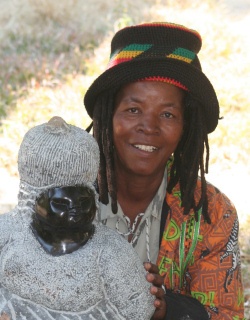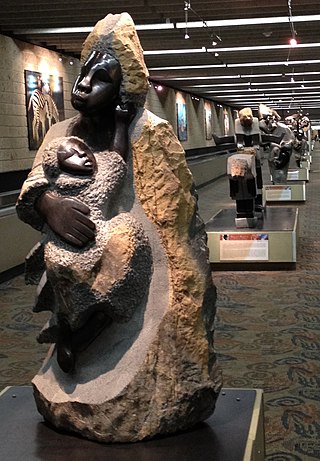Related Research Articles

The Chapungu Sculpture Park is a renowned cultural landmark and sculpture garden in Msasa, Harare, Zimbabwe, which displays the work of Zimbabwean stone sculptors. Spanning over 15 acres of landscaped gardens, the park is dedicated to showcasing the rich heritage of African stone sculpture.

Tapfuma Gutsa is a Zimbabwean sculptor.

Nicholas Mukomberanwa, was a Zimbabwean sculptor and art teacher. He was among the most famous protégés of the Workshop School at the National Gallery of Zimbabwe. He was a mentor to the Mukomberanwa Family of sculptors. Mukomberanwa married his first wife, sculptor Grace, in 1965 and they had eight children. In 1965, he decided to end his career with the police to become a sculptor full-time. He continued to hone his skills over the following decade, developing one of the most distinctive personal styles found in his generation of Zimbabwean stone sculptors. The gambit paid off, and by the late 1970s and in the 1980s his work was being shown in many venues. His work has been exhibited in galleries around the world. He also became mentor to many artists in Zimbabwe, including his children Anderson Mukomberanwa, Ennica Mukomberanwa, Lawrence Mukomberanwa, Netsai Mukomberanwa, Taguma Mukomberanwa,Tendai Mukomberanwa and nephew, Nesbert Mukomberanwa who are also sculptors. He remains one of Zimbabwe's most famous artists.

Locardia Ndandarika, was a Zimbabwean sculptor.
Bernard Matemera was a Zimbabwean sculptor. The sculptural movement of which he was part is usually referred to as "Shona sculpture", although some of its recognised members are not ethnically Shona. His whole professional career was spent at the Tengenenge Sculpture Community, 150 km north of Harare near Guruve.

Joram Mariga has been called the “Father of Zimbabwean Sculpture” because of his influence on the local artistic community starting in the 1950s and continuing until his death in 2000. The sculptural movement of which he was part is usually referred to as “Shona sculpture”, although some of its recognised members are not ethnically Shona.
John Takawira, was a Zimbabwean sculptor. The background to the sculptural movement of which he was a leading member is given in the article on Shona art.

Henry Munyaradzi, also known as Henry Munyaradzi Mudzengerere, was a Zimbabwean sculptor. The sculptural movement of which he was part is usually referred to as "Shona sculpture", although some of its recognised members are not ethnically Shona. He worked initially at the Tengenenge Sculpture Community, 150 km north of Harare near Guruve, which he joined in 1967. In that Community, and ultimately in the wider world of lovers of Zimbabwean art, he was known simply as 'Henry'.
Jonathan Mhondorohuma is a Zimbabwean sculptor.

Colleen Madamombe (1964–2009) was a Zimbabwean sculptor working primarily in stone. Her work expresses themes of womanhood, motherhood, and tribal Matriarchy.
Garrison Machinjili is a Zimbabwean sculptor. He has been working at the Chapungu Sculpture Park since 1989, and has collaborated with many contemporary Zimbabwean sculptors, such as Charles Backford and Benard Nkanjo. His sculptures are generally abstract in nature, but are derived from natural subjects. arrison Machinjili Garrison was born in 1963 in Mazoe, Zimbabwe. He is related to the groundbreaking second-generation Zimbabwean sculptor, Tapfuma Gutsa, and it was during a visit to Tapfuma that he was introduced to stone sculpture. Garrison worked with Tapfuma in 1986. Initially, he sanded and polished sculptures in the final stages of completion. Later, he made his own sculptures, and found a strong personal style emerging during this inspiring early period. In late 1987, he had established his name as an important new talent in the Zimbabwean art scene, and he was invited to join the prestigious Chapungu Sculpture Village as a resident artist, where he remained until 1991 and returning again in 1999–2000. Group exhibitions include: - "African Odyssey: 50 Years of Zimbabwean Stone Sculpture", OXO Gallery, London, UK (2006) - "Custom and Legend: A Culture In Stone", Kew Gardens, London, UK (2000) - Inaugural exhibition at the Chapungu Gallery, Melbourne, Australia (1998) - Zuva Gallery, Scottsdale, Arizona, USA (1998
Brian Watyoka is a Zimbabwean sculptor.
Celestino Mukavhi is a Zimbabwean sculptor.
Barankinya Gosta (1935–1998) was a prominent Zimbabwean Chewa sculptor.

Eddie Masaya is a Zimbabwean sculptor.
Sylvester Mubayi was a Zimbabwean sculptor.

Agnes Nyanhongo is a Zimbabwean stone sculptor.

Sculpture and in particular stone sculpture is an art for which Zimbabwe is well known around the world.
Bronson Gengezha is a Zimbabwean sculptor.
Celia Winter-Irving, was an Australian-born, Zimbabwean-based artist and art critic who wrote extensively on Zimbabwean art, especially Shona sculpture, when she lived in Harare from 1987 to 2008.
References
- ↑ Herald, The. "Mteki carves sculpture for President". The Herald. Retrieved 17 January 2023.
- ↑ "Sepp Blatter was presented with Bryn Taurai Mteki's sculpture". Bulawayo24 News. Retrieved 17 January 2023.
- ↑ Herald, The. "Long live Tengenenge sculpture community!". The Herald. Retrieved 17 January 2023.
- ↑ "Boira Mteki". ZimSculpt. Retrieved 17 January 2023.
- ↑ "Boira Mteki". Chapungu Sculpture Park. Retrieved 17 January 2023.